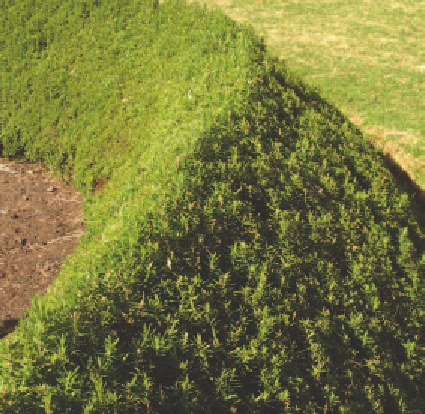Agriculture Reference
In-Depth Information
Planting distances or how to space your
plants
Everyone wants their hedging plants to fuse
together as soon as possible. The hedge will
have clear access to water and nutrients on two
sides, so planting distances can be reduced
from what is usual. Successful planting
distances are dependent on the species used
and the climate of the particular landscape.
Those in areas prone to drought should allow
greater distances than those in wet climates.
Close spacing will reduce the vigour of plants
in the long term - a desirable outcome that
will reduce clipping frequency. However,
adequate soil moisture must be available.
Figure 4.58
The top of the hedge should always be
narrower than the base so that the whole face of the
hedge can receive light.
(Photo taken at Heronswood,
Dromana, Victoria)
Hedges intended to reach 2 m high can be
planted with 75 cm to 1.2 m between the
centres of each plant. Small hedges to
1.2 m tall can be planted at 50 cm to 1 m
centres, and dwarf hedges as close as 30 cm
between plants. Larger distances between
plants will result in a longer period before the
hedge closes together, but at reduced cost of
plant materials.
landscape (see Figure 4.58). It is also
essential for a well-clothed hedge. Each side
of the hedge should have access to the
maximum amount of light in order to ensure
growth from top to bottom. In order for the
foliage at the bottom to receive enough light,
the top of the hedge must graduate back
from the base. A batter of 5 to 10 cm for
every 30 cm of height should be the
minimum for areas at the 40 Parallel and
beyond (degrees north or south of the
equator). A more vertical incline is
satisfactory between the equator and the
40th Parallel. If the hedge develops an
overhang at the top, the basal growth often
dies leaving a nasty stretch of dead wood, or
worse, a wind tunnel underneath (see
Figure 4.57). In order to induce good dense
basal foliage, prune back the side growths by
about at least a third to encourage the stems
Initialpruningatplanting
It is best to select young plants with many
branches originating at or near their base.
Unless the plants have been grown
specifically for hedging this is unlikely to
occur in advanced plants.
All hedges should be trained to be wider at
the base tapering to their top. An 'A' shape is
ideal. Nevertheless, practice can be different.
If your region is warm and sunny, a more
vertical slope can be successful. A hedge
wider at the base is aesthetically more
pleasing, adding an air of stability to the

